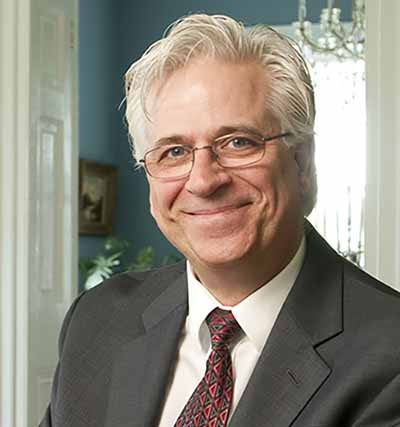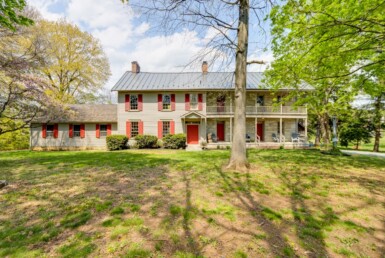Historic William Chapline House Brief History
On the northwest corner of Sharpsburg’s town square stands a handsome stone house with a raised-seam metal roof, its portico resting on the sidewalk before it.
The house features five bays wide, two stories high, with a finely coursed limestone façade, and flat stone arches above its windows, with less formal rubble stonework on the other facades. A shed-roofed brick ell was added at its rear, likely in the late1820s or 1830s. The main entrance to this Georgian home is in the middle bay and opens into a central hall with a staircase to the second floor and attic. Turned 18th century balusters and pinwheel decorations adorn the stairs and a six-panel door to the cellar hangs on strap hinges. It is interesting to note that this house has stood firm for the entire history of the United States, as it was virtually complete when George Washington was inaugurated as president in April 1789.
The property’s origins date to 1738, when trader and tavern keeper Edmund Cartlidge received a patent for a square tract of land, 3,300 feet on a side, including the site where the W. Chapline house currently sits. Cartlidge named the land “Hickory Tavern,” suggesting that he had some kind of commercial operation at that place — perhaps his trading post or tavern — because the property sat along an ancient native American path and a portion became the Monocacy portion of the of the great wagon road that led across the Potomac and west.
Twenty-five years later, Joseph Chapline acquired land that included Cartlidge’s “Hickory Tavern” and laid out his town, naming it after Horatio Sharpe, the proprietary governor of Maryland from 1753 to 1768. Chapline and his heirs sold lots measuring 103 feet wide by 206 feet deep for as little as a shilling each, expecting to profit from the ground rents specified by the deeds. The most expensive of these lots was No. 47, the northwest corner of the town square, which Chapline sold for 20 pounds, indicating that some improvements lay of the lot, possibly remains from Cartlidge’s enterprise. It is believed that construction on the current stone house began in 1787.
In 1789, Michael Myer paid 80 pounds for Lot 47, indicating a large improvement, probably the stone house. Because a completed stone house would have been worth around 300 pounds at that time, the house may not have been finished, or some other arrangement was made.
Myer apparently got in over his head, and William Chapline, a saddler and son of Joseph Chapline’s brother Moses, took over the debt via a bond. He moved into the house, then divided the lot in two and sold the western half with the initial structure on it.
A little more than a year later, Chapline found a buyer — Frederich Kuhnes— for the eastern half of the lot with the stone house on it and assigned his bond of conveyance from Myer to all of lot 47 to Kuhnes. this contract with Kuhnes recorded:
“Sharpsburgh 20th of Feby 1792. Whereas I have this day purchased from Mr William Chapline saddler his sd Chapline stone house with half of the lott where sd house stands in this Town & sd Chapine has this day assigned to me a bond of conveyance which him said Chapline received from Michael Myer for a deed of conveyance for the whole lott Since the date of sd Bond sd Chapline has sold that half of the Lott adjoining George Kifers to a certain John Shott therefore notwithstanding the bond is Signed over to Koons by Chapline for the whole Lott I therefore certify that I am to make or cause to be made a lawful deed of conveyance to sd Shott for said half Lott which the sd Shott purchased from sd Chapline as soon as I may get a Deed from Myer for sd Lott as witness my hand and Seal this day above written Frederich Kuhnes.”
And thus the house received its name, although William Chapline appears to have been associated with it only briefly between 1790 and 1792. William Chapline’s name did not appear in any other land record in Washington County. Chapline family records said he married Miss Johnson and lived in Sharpsburg in the stone house near the public square, then moved to Wheeling, W.Va., and died in 1809, childless.
John Hartman, a physician, purchased the house in 1796. Hartman died in 1819 and his wife followed him three years later. In 1821, one of her heirs, Catherine Myers, purchased the house from other heirs for $100. The Myerses are probably responsible for the brick ell addition with the two-story gallery porch at the rear of the house. Phillip Myers is said to have run a store and a tavern in the house, probably on the first level of the east side, in the only room to retain its original 18th C woodwork (along with the floors and the stairs previously mentioned).
The brick extension has two rooms on each floor with smaller rooms at the ends of the porches (which now contain bathrooms). The purpose of these small rooms where likely for storage but there was a hand dug well and hand pump in the downstairs room, with an access door into the kitchen.
All plumbing, kitchen and bathrooms have been placed in the brick wing of the house.
In 1850, Dr. Augustin A Biggs purchased the house for $800. His office and apothecary occupied the first floor of the house east of the entry hall. A cut stone step outside the door is engraved “Dr. A.A. Biggs.” This room retains its original woodwork with a handsome fireplace mantelpiece decorated with molded crossettes, a row of dentils and an arched firebox and brick hearth. A door at the back of the space, once an exterior door, now enters the brick wing. An alcove beside the door was originally a window.
Shortly after purchasing the house, Biggs opened the double parlors on the west side of the first floor into a single large room, enlarging its windows and recessing paneled dadoes cut into the stone walls. He was interested in updating the features of the home, and he had the stone house painted red. New alcoves flanked the fireplaces and new mantelpieces were installed. The original heart pine floor remained.
A brick smokehouse attaches the rear of the house with a covered space that once might have contained a brick oven. Architectural evidence indicates at one time there was a door that led into the main house from this location and a kitchen back stairway led upstairs to servants living space. The stairway was covered over in 1982 to convert the space into an upstairs laundry room. There is also a living space in the attic which contains early 19th century scribblings and some pencil drawings of 1812 era soldiers. This attic space may have been used as either servant living space or itinerant workers lodging.
A two-story brick stable at the back of the property sits in the corner created by the west and rear property lines. It is deemed a stable because there are no large doors to admit buggies or wagons. The stable’s unique brick fretwork façade faces the house. It is interesting to note that roof beams in the stable are hand cut 18th century timber, indicating reuse from an earlier structure, possibly the original 18th century summer kitchen. The stable was used up to the 1940s.
On Sept. 17, 1762, the Battle of Antietam arrived at Sharpsburg with its more than 23,000 casualties and all its horror. Biggs tended many wounded; stains on the office floor were said to be the blood of a soldiers. Biggs wrote of dead and wounded soldiers in the street. After the battle the first floor of the stone house was used as a hospital.
During the battle the town was intensively shelled by overshooting Union artillery and the house received at least 5 artillery hits and the stable two strikes. One shell entered Biggs bedroom and upstairs parlor (now the MBR) and exploded causing extensive damage. The house and stable caught fire but because Biggs never evacuated the house and sheltered in the cellar, he was able to quickly extinguish the fire. Minor traces of fire char can be seen in the attic, and the massive timbers in the stable still show extensive fire char.
There is a beautiful and handsome early 19th C carriage step and hitching post out front of the house. According to oral tradition, and first-hand accounts President Lincoln and President McKinely used these steps. (Ref article written by Colleen Stone in the “Maryland Cracker Barrel” and in the book “Sharpsburg” by Vernell and Tim Doyle.
After the civil war, Biggs undertook a major renovation of the house, probably to repair war damage and probably partially paid for with restitution money. He replaced all of the windows with double-hung, six-light sashes and added the decorative cast-iron porch where there had been no porch before. He replaced original interior doors with four panel doors with cast-iron locks and ceramic knobs and changed the woodwork to molded trim with square corner blocks and high molded baseboards. The two-leafed entrance door with it original cast-iron double lock, ceramic knobs, large brass keys, cast-iron doorbell and elegant multipaned transom also dates to this period. After the war, Biggs planned, designed and ran Antietam National Cemetery.
Biggs continued practicing medicine until he died in 1889, and his children continued to own the house until 1943.
In 1968, John and Beverly McCollom purchased the property and, with the help of Dr. Paula Reed and her husband, Douglass Reed, both professional preservationists, researched its history and had it placed in the National Register of Historic Places. The Reeds purchased the house from the McColloms 10 years later. The Reeds are responsible for the elegant glass atrium at the rear of the house, a curtain to shield the double porches and form a garden room with a herringbone brick floor.



